A legacy of a community that is built upon or near to a limestone escarpment are the natural resources that comes with it. Just one such resource is clay that is suitable for the production of bricks, tiles and earthenware pottery. Scattered around Coxhoe and its outskirts are the scars of an industry long since vanished. Careful exploration of the landscape will reveal claypits, some filled with water that provide fishing as a leisure time activity or others that are hidden by overgrown area of trees.
During the 1980’s when the Coxhoe link road was constructed pottery kilns were uncovered on a site opposite the former Black Horse public house at the bottom of Station Road West. A number of clay pipes were discovered in an area known as Cornforth Pottery.
An area of Coxhoe is known as the Pottery and it was here that Ralph Carnaby, The Harwood family, The Cowburn family and a succession of other individuals produced bricks, tiles, rough earthenware and even clay pipes over a great many years. The links below provide articles and information about those involved in the brickmaking process.
In 2015 The Pottery was developed for housing and as part of that an archaeological survey had to be carried out. It turned up some very interesting results in terms of the structures uncovered rather than the scarcity of artefacts. A full report conducted by Archaeological Research Services Hebburn based office can be found below.
Brick, Tile & Pottery making Timeline
1760 ;- Deeds of Coxhow Manor bought by John Burdon mention lands belonging to Samuel Lammas
1765 :- 26 Dec birth of Ann daughter to Samuel Lammas( potter), died 1772
Before 1769 :- Coxhoe Pottery was owned by Lammas (Tax Assessment Records)
1772 :- 27 April burial of Ann daughter of Samuel Lammas, Coxhoe Pottery
1777 :- 1 July burial of John, son of Samuel Lammas, Coxhoe Pottery
1787-1792 :- Samuel Lammas – Tax Assessment for Coxhoe
1793 :- 24 Feb burial of Samuel Lammas
1828 :- Peter Harwood earthenware manufacturer at Cornforth Pottery
Joseph Lammas, earthenware manufacturer, Cornforth
David Birkett was a brick & tile-maker in the Tile Sheds, Cornforth. He died 1851.
1828-1832 :- Thomas Harwood manufacturing earthenware at Coxhoe Pottery
1835:- Lammas and Birkett leased land at Parkhill
1851:- David BIRKETT, tile-maker, of Coxhoe Tile Sheds Died 25 February 1851
1851 :- Ralph Carnaby employed 8 men & 1 boy res at Cornforth Villa 1851,
Thomas Birkett farmer and tile maker, Cornforth Tile
1855 :- Mary Lammas leased the pottery to William Bell who made Brown Earthenware (Durham Palace Green Archives)
William Rowe tobacco pipe maker, Blackgate
1856 :- Thomas Birkett of Crow Trees Tile Works
William Field jun. Cornforth & Coxhoe Brick Works
1858 :- William Cowburn, brick and tile manufacturer
Ralph Carnaby agent to West Hetton Colliery residing Cornforth Villa
Harrison Rowe, tobacco pipe manufacturer, Cornforth Pottery
1864 :- Accident at Carnaby’s Brick Yard
Thomas Castling, a potter at Coxhoe Pottery (in graveyard)
William Field in Cow Close
J Steele, earthenware dealer
John Armstrong, earthenware dealer
1868 :- Thomas Birkett, farmer & tile maker, Cornforth Tilery
Mary Lammas, earthenware manufacturer & farmer in the Pottery
John Rowe tobacco pipe maker, Pottery
1870 21 May Tom Barker wins handball game and becomes World Champion Fives Player. Uses his winnings to buy a brickyard.
1879 Robert Rutter in Clarence Villa Hotel
1881 William Booth is the Occupier, William Cowburn the proprietor of the Brick Yard
Thomas Robinson res Blackgate, master potter employing 3 men, 2 women, 3 boys.
1890 William Booth & Luke Hall are brickmakers
John & Thomas Robinson are earthenware dealers at Coxhoe Pottery
David Birkett of Crow Tree Tile Sheds
1891 Thomas Robinson (son of Joseph Robinson a potter from Norton)res Cow Close-earthenware dealer & assist Overseer
1894 Booth, William & Hall brickmakers
John & Thomas Robinson are earthenware dealers at Coxhoe Pottery
1898 William Booth & Luke Hall are brickmakers
John & Thomas Robinson are earthenware dealers at Coxhoe Pottery
Fleetham vict of Clarence Hotel
After 1901 Tom Barker opens a brickyard opposite the Kicking Cuddy. It closed in 1914
1902 -1910 Thomas Robinson, wholesale earthernware dealer
1911 Luke Hall is a Brick & Tile Maker at Coxhoe Pottery
Thomas Barker, brick maker residing at Prospect Place
1914 Nelson Digby & Son, Slate merchants, Blackgate
Thomas Lewis Robinson, ( son of Thomas) wholesale earthernware dealer, Post Office
1920 Thomas L Robinson, wholesale earthernware dealer & PO
Ralph Carnaby, Brick maker
Ralph was born 1818 Westoe, South Shields and started his early working life as an agent in South Shields. He married Martha Hart there but moved to Coxhoe before 1848 where the first of his eleven children were born.
In 1851 the family are living in Blackgate and Ralph is a professional brick manufacturer employing 8 men, 2 women and a boy. The 1858 Trade Directory also list him as an agent to West Hetton Colliery, residing in Cornforth Villa. After securing more clay deposits at West Hetton & Quarrington in 1867, Ralph and family move to Clarence Villa. He liquidated before 1879 and retired to Westoe, South Shields.
NEWCASTLE JOURNAL Sat 25 June 1864
Fatal Accident at Carnaby’s Brick Yard
An inquest was held at Coxhoe on Wednesday, on the body of Mary Alice Crooks who was killed at Mr Carnaby’s brickyard manufactory, on Monday afternoon. The turnpike at Coxhoe is crossed by a branch line of the West Hartlepool Railway. About two hundred yards from the crossing there is situated a fire brick manufactory, the property of Mr R Carnaby. The rails leading to the factory are down in a very steep incline. At the bottom situate the brick works, and in those works the accident occurred. The men were engaged in filling with rubbish a set of ten wagons which were standing on the incline.
Between six and seven yards higher up there were three wagons. On the engine – man backing his engine to remove these three ‘empties’, they ran down the line, and the impetus communicated to the nine standing wagons was such as to cause them to go with great force down the incline against the building. One end of the brick factory – a thick wall- was knocked completely in, and one of the laden wagons was forced into the interior of the building.
There were working girls and married women. One of the girls , named Mary Alice Crooks, and Mrs Richardson, the married women already referred to, had no opportunity of seeing what was going on outside. Suddenly there was a great crash, the end of the building fell, and the wagon laden with ballast broke through the debris, and the young women buried beneath a mass of stones and earth.
The girl Crooks was completely smothered, but the other two were only partly covered although the injuries they received were of a serious nature. The woman Richardson strange to say, was unhurt. The age of the diseased girl is thirteen years. Of the other two girls, Elizabeth Smith age 16 years is the most seriously injured, some of her ribs being broken.
The jury’s verdict ‘Accidental Death’ accompanied by a recommendation that something should be done to prevent the possibility of such an accident occurring in the future.
Lake Superior Discovery
Carnaby bricks travelled the world. News reached the history group via email from Dan Koss, in Michigan, USA, that the discovery of a long lost copper mine known as Cape Exploration Mine from 1851, in the Keeweenaw Penisula in Lake Superior has revealed hearth bricks manufactured by Carnaby of Coxhoe with the makers name stamped on the brick.
Heres what Dan had to say about the discovery they made.
“Located the long forgotten and lost 1851 Cape Exploration mine in the Keweenaw Peninsula of Michigan\’s Lake Superior Copper District. Found an old hearth with some bricks marked CARNABY COXHOE. The only port at that time was Copper Harbor and nearby Fort Wilkins. Those bricks made it all the way from England.
Attached are 3 photos of the hearth and bricks. The hearth is in poor condition, but many of the bricks are laying about. We found a second hearth in the vicinity, but it was constructed of local mine rock. How Carnaby Coxhoe bricks made it to the Lake Superior copper district in 1851 is a wonder. My guess is they were probably ballast on a ship of goods to Fort Wilkins at Copper Harbor. Considering the area was wilderness in 1851 and the bricks ended up in a hearth at a remote mine site inhabited by probably no more than 8 to 10 men, it is an oddity. All goods shipped into Lake Superior at that time had to be portaged around the rapids at St. Mary’s river or across the straits of Mackinaw. It certainly made no economic sense to ship bricks from England-so they were most likely reused ballast.”
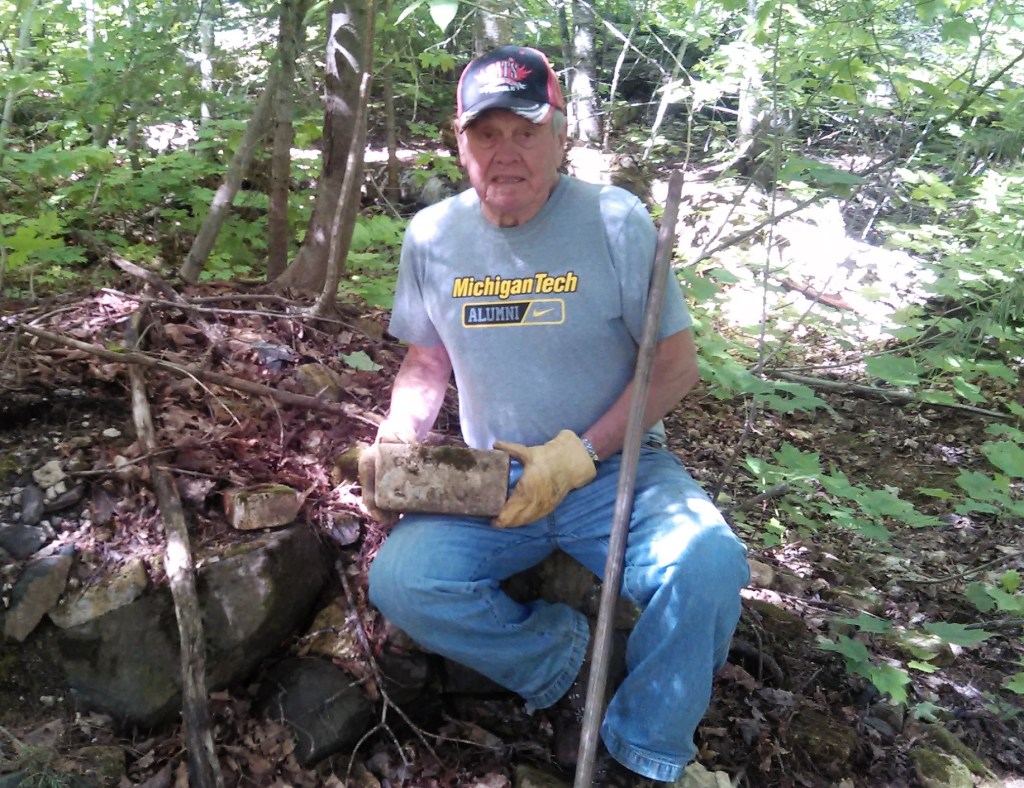
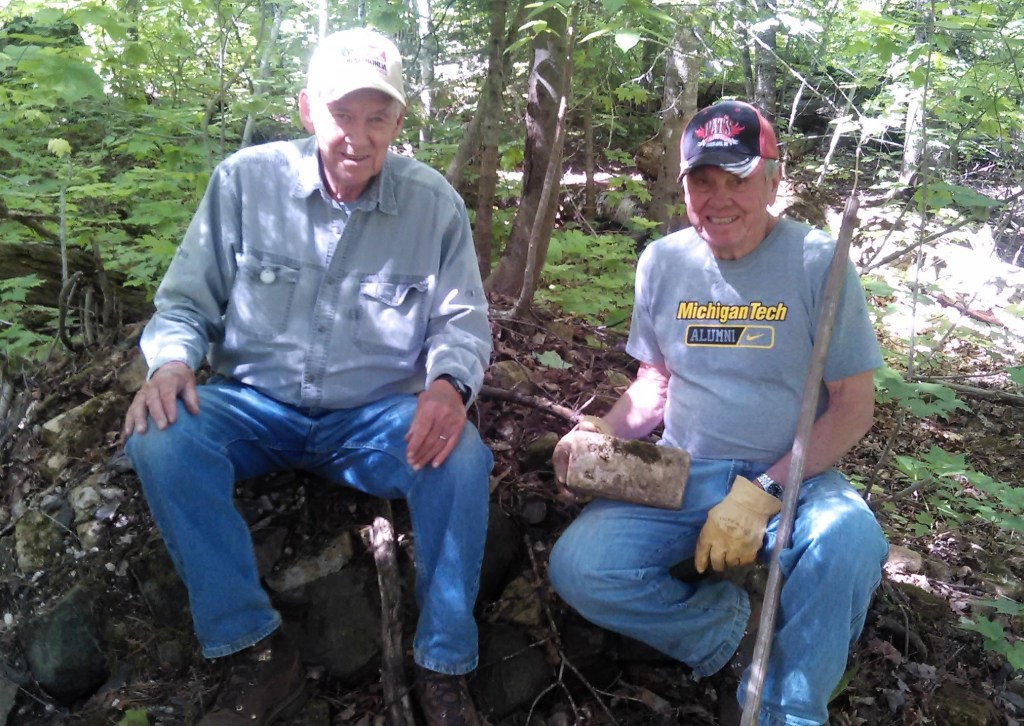

“In the photos, I am the fellow in the Michigan Tech Alumni T-shirt and the other guy is Ron Erickson from Wisconsin who originally re-discovered the mine site. My brother Ken Koss took the pictures with his cell phone. It took the three of us over three hours in the woods on ATV’s and hiking to rediscover the rediscovered mine site. Finding the old hearth was another hour of roaming about. Regards, Dan Koss, Ken Koss, Ron Erickson.”
The Coxhoe Link Road Discovery
In 1982 in a move designed to take increasing amounts of traffic away from the centre of Coxhoe, Durham County Council proposed a southern link road that would join the A177 with the A688 at Tursdale and the A1M at Bowburn.
Creating a junction at the Black Horse Hotel involved excavations that uncovered intact pipe kilns that were once owned by Harrison Row, pipe maker.
Local historian & amateur archaeologist Robin Walton along with friend excavated the kilns and discovered an number of relics found intact in the kiln.
This gallery of photographs depicts the excavation and the discoveries.
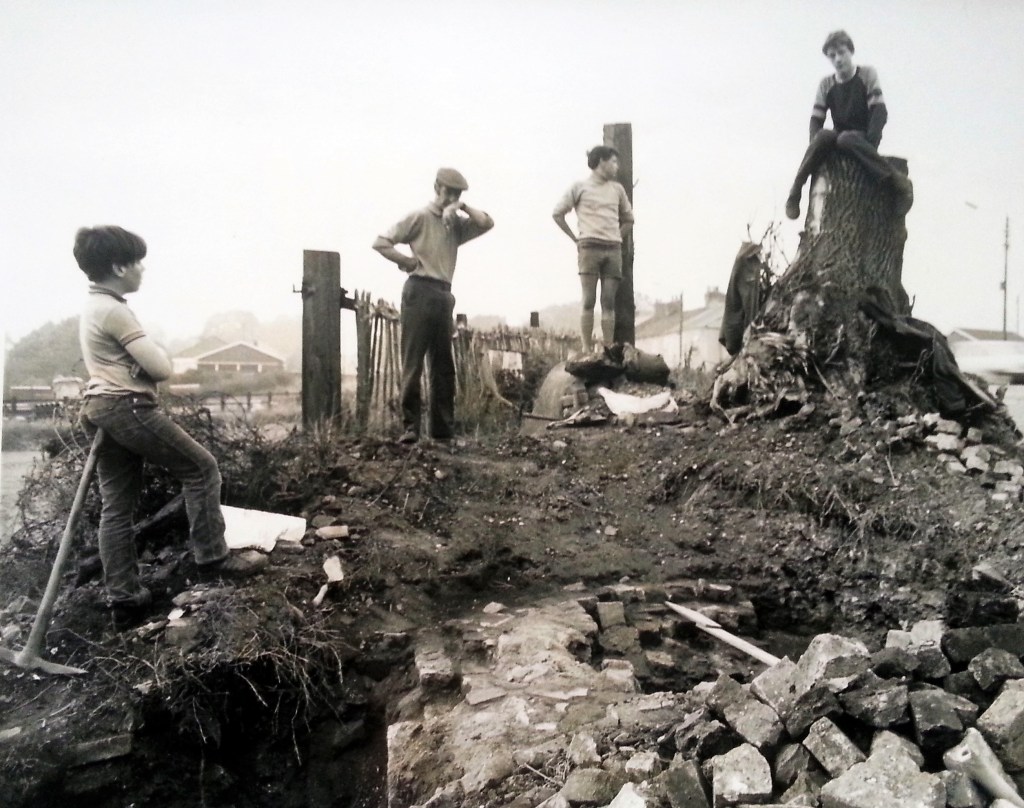
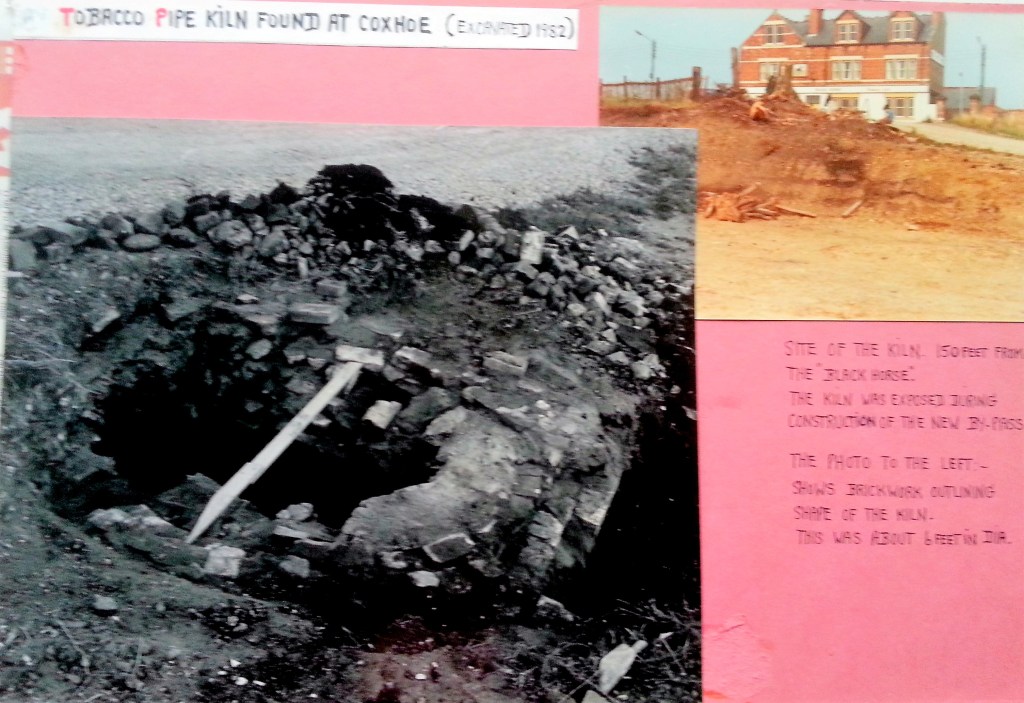

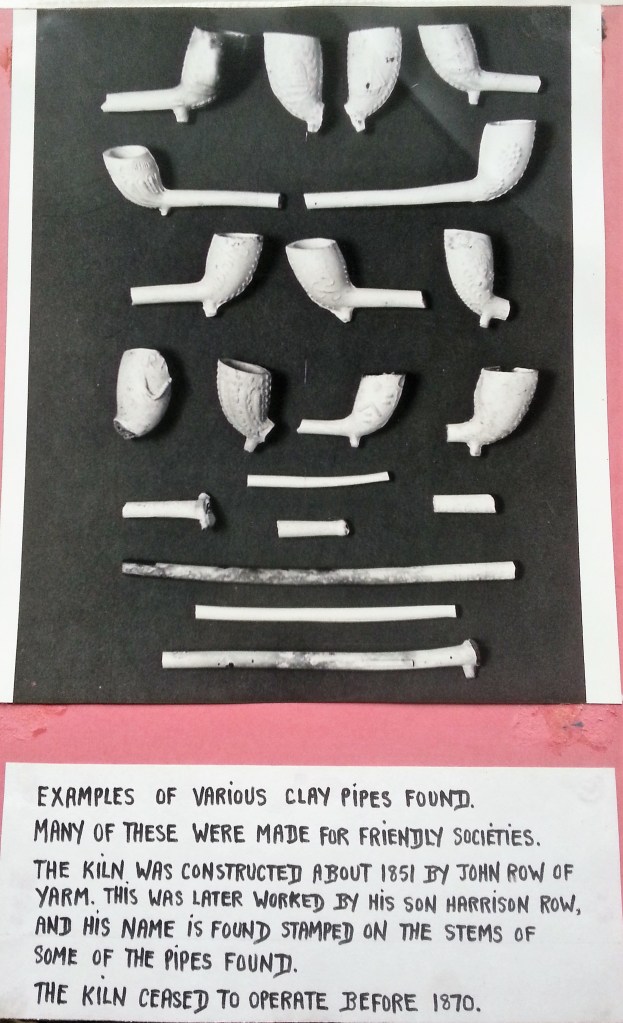


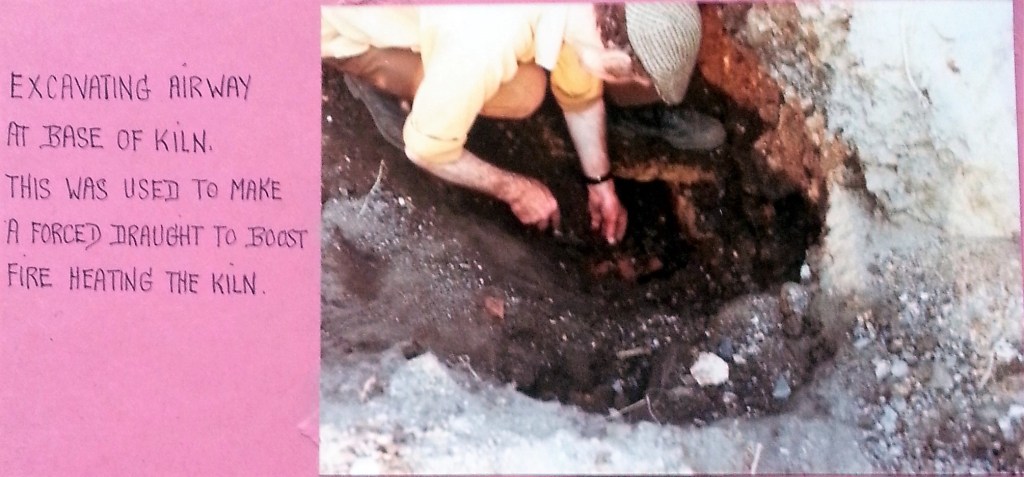
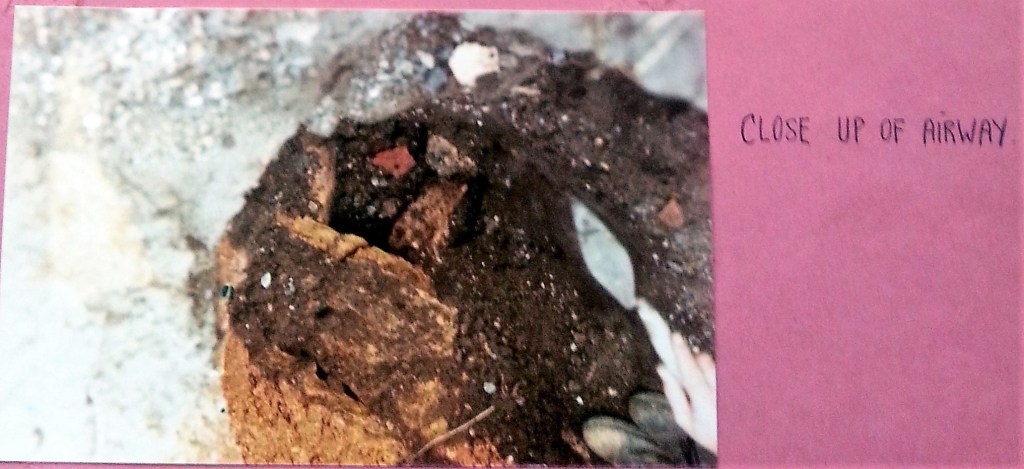
An area of Coxhoe is known as the Pottery and it was here that Ralph Carnaby, The Harwood family, The Cowburn family and a succession of other individuals produced bricks, tiles, rough earthenware and even clay pipes over a great many years.
In 2015 a derelict piece of land behind the The Potteries street was re-developed for housing and as part of that, an archaeological survey had to be carried out. It turned up some very interesting results in terms of the structures uncovered rather than the scarcity of artefacts.
The small housing estate known as Majolica Mews is were the excavations took place.
As the newspaper report from the Durham Advertiser report below shows, many of the structures that were involved in brick and tile making.
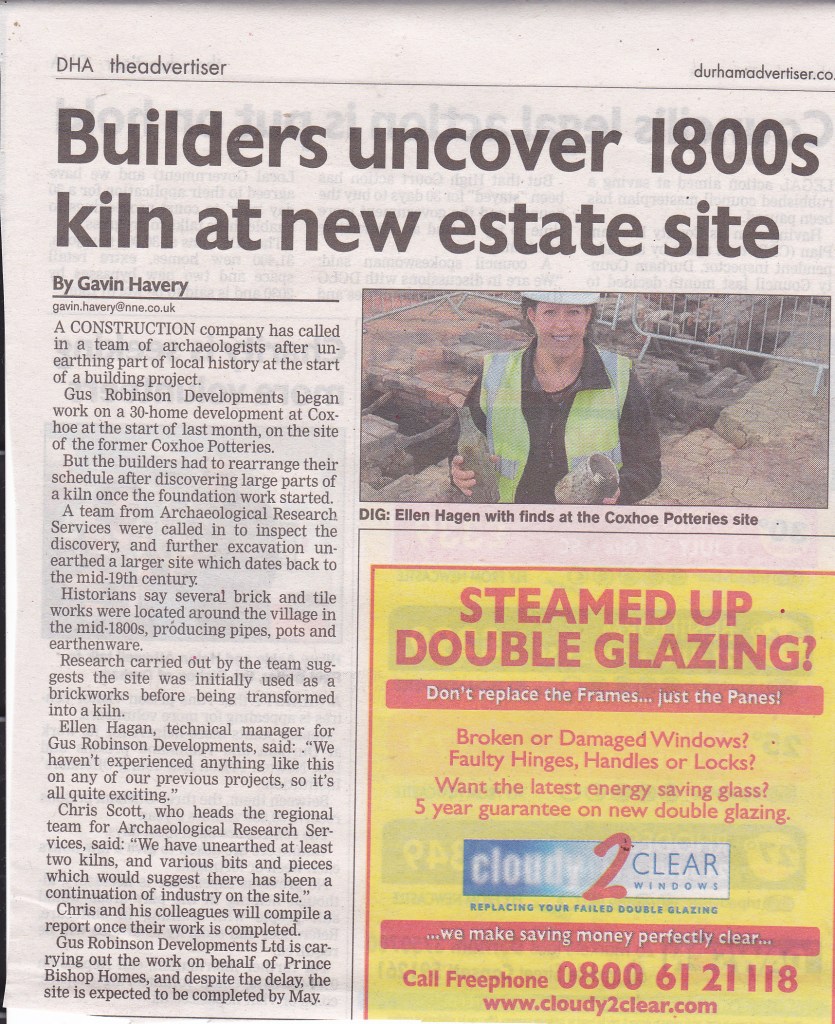
The following gallery of photographs shows the extent of the brickworks and the types of kilns involved in making them.









